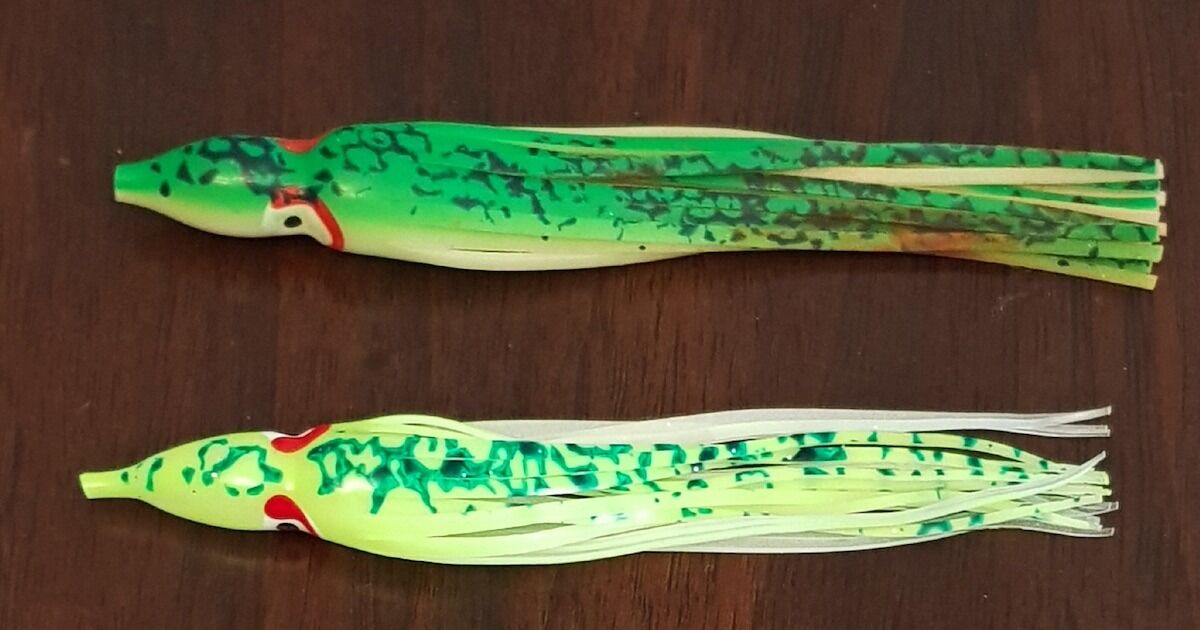
Here we go again with the hoochie colours. This time we’ll look at matching squid and cuttlefish bait for salmon fishing, not just using hoochie colours to match anchovy, needlefish, or small herring. Marine biologists are still learning about squid and cuttlefish, and what follows is just based on my fishing experience. We will briefly skim the surface of squid and cuttlefish colours, as well as their life cycle, hopefully to help you catch more salmon.
Squid and cuttlefish can change colour to match their surroundings
All underwater creatures have UV and colour pigment in their skin, but squid and cuttlefish have many colour cells under their skin. When they activate the colour cells, we often see the dot and line patterns. The typical colours are black, brown, orange, red, or yellow (chartreuse). Spatterback hoochies work well for salmon because of the dot patterns on their skin. When squid and cuttlefish are alive, they have an iridescent shine, which is a form of UV reflection. Typical UV iridescent colours are green, blue, silver, and gold. Therefore, oil slick and UV colour hoochies typically work well. Squid and cuttlefish also communicate by changing colour, though we still do not know exactly what they are “saying.” They change colours to match the kelp, rocks, coral, water, and other surrounding structure. That opens up a lot of colour choices to match hoochies to the surroundings.
How To Pick a Hoochie for Fishing
Common hoochie varieties
The general idea is to match the water colour before choosing the dot or line patterns. The green and chartreuse colour with white body is the typical go-to colour year-round in mid-water depths around the island. In winter, there’s sometimes an odd bluish or purplish colour in the water, so we use the light blue colour with white body or Purple Haze. To match the lines or dots on the squid and cuttlefish, start off with black or dark colour dots or lines, then move to your brown, orange, and red dot/line colour patterns. Of course, use UV colours, because all living creatures have some sort of UV when they are alive. Use glow when fishing deep. When you are fishing near structures and bottom, match the surrounding colours. Fishing near mud and rocks, use a brownish colour with black or brown dots. If it is a sandy bottom with gravel, use a light brown or beige colour with orange dots. The same goes for structure fishing: Use UV colours or oil slick to get more lifelike patterns. Around kelp or shoals, use darker green with dot patterns or lines. Army Truck works in those situations. When you can’t get oil slick on your hoochie pattern, just add some mylar flash inserts to give some UV flash.
The “Hoochie Life Cycle”
All these colour patterns can be used during most of the year around the island. Squid start spawning from April to October in most Pacific Northwest waters. During this time, mature spawning squid will start to develop egg sacs. Adding glow beads or red beads makes the hoochie look like it has eggs. This means higher protein from the “fish eye” point of view. Between June and October, start to use more UV white and plain white hoochies.
UV white could indicate the squid is half dead, or not interested in mating. Red
or chartreuse dots on the UV/glow white hoochie makes it look like it’s in distress. A UV clear body with glow dots works the same for fishing deeper water. When a squid is dead, the whole body turns white and doesn’t really have any dots or lines. Squid die after spawning just like salmon do.
White hoochies mimic dead or dying squid
Have some of these squid and cuttlefish hoochies pre-tied and ready to fish to the conditions. When fishing with UV white or plain white, keep the leader length short so the hoochies have erratic action. The same goes for Blue Meanie hoochies—keep the leader short, because blue squid/octopus usually are angry. I have all my hoochies tied up with 50-lb mono line and a length between 24″ and 36″(see Fishing Essentials: The Flasher and Hoochie Setup). UV white hoochies OA12R with some red beads have been killer for late summer and fall salmon fishing. Give it a try.
This article appeared in Island Fisherman Magazine. Never miss another issue—subscribe today!
Visit the Store
$34.99
$34.99
Featured Catch
Joel Unickow halibut (Photo: Rob Frawley Lucky Strike Sportfishing Tofino)




